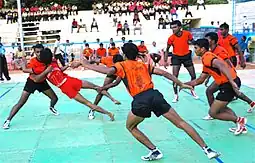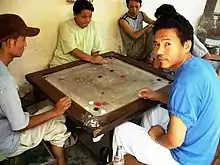
South Asia has many traditional games and sports. Two of them, kabaddi and kho-kho, are played at the South Asian Games, with kabaddi also featuring at the Asian Games.[1] Many of these games are played across the entire subcontinent under different names and with some rule variations, while some of these games may be played only in certain countries or regions.
History
Some traditional South Asian games, such as kabaddi, kho-kho, and atya-patya, are believed to be thousands of years old, dating back to ancient India.[2][3][4] Kho-kho, for example, dates back to at least the fourth century BC.[5] Many South Asian games likely reflect characteristics of traditional life in the subcontinent; for example, the Bengali hopscotch game of ekka-dokka (related to Stapoo and Chindro) may reflect the concepts of land division and ownership of property in ancient times.[6]
After the British colonisation of the subcontinent which peaked in the 1800s and afterwards, Western sports such as cricket, football, and hockey began to be followed to a greater extent, to the detriment of the traditional games.[7] The modern advent of urbanisation,[8] globalisation (which attracted people towards more globally popular games),[9] and technology (which gave people digital forms of entertainment such as the Internet, television, and video games)[10] have further diminished the traditional South Asian sports.[11] Additional reasons include religious extremism in some areas, which has restricted people from playing certain games, and lack of governmental support.[12]
However, some professional leagues are now being started for certain traditional sports, such as the Pro Kabaddi League, Ultimate Kho Kho, and Pro Panja League, which are beginning to revive interest in these sports and even globalise them;[13][14] these leagues are now some of the most-watched competitions in the subcontinent.[15]
Traditional games
Gillidanda
Gillidanda or gulli danda is a game where players attempt to hit a stick as far as possible to score points. It has similarities to the popular South Asian sport of cricket, as well as to traditional games around the world, such as tipcat.[16]
Chindro

Gutte
Gutte (similar to Meergati and Bilghotti in Pakistan) involves players throwing up and then grabbing stones on the ground, while ensuring none of the stones falls from the air to the ground.[17][18][19]
Dark room
Dark room is the same as hide-and-seek, except that it is played in an entirely dark room.[20][21]
Donkey Donkey
Donkey Donkey (similar to the Pakistani Beech ki Billi)[22] is a game in which two players attempt to throw a ball to each other, while a player in the middle tries to catch it.[23]
Ball games
Maram pitti
Maram Pitti (similar to Pakistan's Maran Kuttai)[22] is similar to dodgeball.[24]
Seven stones
In the game of seven stones (known by several other names in various regions), one team throws a ball at a pile of stones and then attempts to rebuild the pile, while the other team tries to eliminate the first team's players by throwing the ball at them.[25][26]
Variations of tag
Deciding who the denner is
In many South Asian variations of tag, the player meant to tag the other players is known as the "denner".[27][28] There are various ways of selecting the denner, such as Saa Boo Three (also known as pugam pugai), in which a group of three players face one of their hands up or down, and if one of the players faces their hand the opposite way of the other two, then they are chosen as the denner.[29][30]
Kabaddi

Kho-kho

Kho kho is a traditional Indian sport that dates back to ancient India.[32][33] It is the second-most popular traditional tag game in the Indian subcontinent after kabaddi.[34] Kho kho is played on a rectangular court with a central lane connecting two poles which are at either end of the court. During the game, nine players from the chasing team (attacking team) are on the field, with eight of them sitting (crouched) in the central lane, while three runners from the defending team run around the court and try to avoid being touched.[33] Each sitting player on the chasing team faces the opposite half of the field that their adjacent teammates are facing.
At any time, one player from the chasing team (the 'active chaser'/'attacker') may run around the court to attempt to tag (touch) members of the defending team, with one point scored per tag, and each tagged defender required to leave the field; however, the active chaser cannot cross the central lane to access the other half of the field, and cannot change direction once they start running toward either pole. The chasing team can get around these restrictions if the active chaser either switches roles with a sitting teammate (by touching them on the back while saying "Kho") who is facing the other half of the court and therefore has access to it, or runs to the area behind either pole and then switches direction/half. Each team has two turns to score and two turns to defend, with each turn lasting nine minutes. The team that scores the most points by the end of the game wins.[35]Freeze tag
Freeze tag (also known as Baraf Paani in North-India and Pakistan, and as Borof Paani in Bangladesh) involves players becoming "frozen" in place when tagged by an opponent, but becoming unfrozen when tagged by a teammate.[36][37]
Atya-patya

Langdi

Aankh micholi
Aankh micholi (similar to Bangladesh's Kanamachi) is a form of blindfolded tag.[17][44]
Kokla chappaki
This game (similar to Rumal Chor and Bengal's Rumal Churi) is similar to duck, duck, goose.[45][46][47][48]
Oonch Neech
Board games
Snakes and ladders
Carrom

See also
References
- ↑ "OCA » Ancient tag game of kho kho catching on fast". ocasia.org. Retrieved 17 November 2022.
- ↑ Kabaddi: How to play India’s 4000-year-old indigenous sport Olympics.com
- ↑ Kho Kho, a kabaddi-like sport linked with Indian epic Mahabharata – know all about it Olympics.com
- ↑ Arasu, S. T. (4 July 2020). "Galah Panjang and its Indian roots". On the sport. Be part of it. Retrieved 19 November 2022.
- ↑ "The Evolution Of Kho Kho Mats In India: A Historical Overview". English Jagran. 30 May 2023. Retrieved 8 August 2023.
- ↑ A Historical Study of the Origin and Features of Some Selected Folk Games in North Bengal Badal Roy https://ir.nbu.ac.in/
- ↑ Disappearance of Traditional games by the imitation of Colonial Culture through the Historical parameters of Cultural Colonialism Md Abu Nasim https://dergipark.org.tr/
- ↑ Games and Sports in West Bengal under Global Urbanization: An Ethnographic Approach Dr. Abhijit Das http://www.ijhssi.org/
- ↑ Bengal Traditional Games and Sports Culture Around in Twentieth-Century North Bengal Badal Roy & Dr. Sudash Lamahttps://ir.nbu.ac.in/
- ↑ Pant, Charu (16 August 2015). "Five Indian Origin Games on the verge of extinction – Sports". Retrieved 19 November 2022.
- ↑ TRADITIONAL GAMES AND SPORTS Siben Paul http://oldror.lbp.world/
- ↑ Folk Games Dying in Pashtun Belt: A Combination of Religious Extremism Confining Girls to Their Homes and Urbanisation Providing New Options nayadaur.tv
- ↑ India's defeat reflects Kabaddi's globalisation: Coach Reddy https://www.business-standard.com/
- ↑ "Format, game tweaks have helped draw fans on TV: Ultimate kho kho CEO". Hindustan Times. 3 September 2022. Retrieved 19 November 2022.
- ↑ Taneja, Nidhima (27 January 2023). "Pro kabaddi, kho-kho leagues chase IPL viewership. India rediscovering regional sports". ThePrint. Retrieved 8 August 2023.
- ↑ "Gilli Danda or Guli Dunda (India, Bangladesh, Nepal, Afghanistan, Pakistan) – Traditional Sports". www.traditionalsports.org. Retrieved 17 November 2022.
- 1 2 Kazi, Saad (14 June 2018). "Top 24 Most Popular Traditional Indian Games Gen Z Must Try". Voice of Indian Sports – KreedOn. Retrieved 17 November 2022.
- ↑ Folk Games Dying in Pashtun Belt: A Combination of Religious Extremism Confining Girls to Their Homes and Urbanisation Providing New Options
- ↑ "Imaginative games: Cheap shot". The Express Tribune. 25 August 2013. Retrieved 17 November 2022.
- ↑ "If These 27 Childhood Games Were In The Olympics, We'd All Win Gold". ScoopWhoop. 24 October 2016. Retrieved 20 November 2022.
- ↑ "11 childhood games today's kids are unlikely to play". The Express Tribune. 11 March 2015. Retrieved 20 November 2022.
- 1 2 Cheema, Minahil (2 August 2015). "15 of the Greatest Games All Pakistanis Grew Up Playing". MangoBaaz. Retrieved 20 November 2022.
- ↑ Agarwal, Stuti. "The games we played – Times of India". The Times of India. Retrieved 20 November 2022.
- ↑ Wilben Albert, Renin. "IPL 2021: [Watch] KKR players have a ball while enjoying a game of 'Maram Pitti'". www.sportskeeda.com. Retrieved 20 November 2022.
- ↑ Enos, Jayaseelan (14 August 2012). "Seven Stones: A Traditional Game in India". Compassion International Blog. Retrieved 17 November 2022.
- ↑ "Traditional Games of Pakistan – Muhammad Awais – Youlin Magazine". www.youlinmagazine.com. Retrieved 17 November 2022.
- ↑ "Lock and Key to Pittu: 13 outdoor games every 90s kid would remember". InUth. 6 September 2017. Retrieved 6 August 2023.
- ↑ AK, Ananya (10 August 2018). "10 Games You Played If You Were Born In The 90s India". Campus Times Pune. Retrieved 31 October 2022.
- ↑ Gosain, Srishti (10 March 2016). "12 Games Every 90s Kid Played And We Miss These". LifeCrust. Retrieved 4 August 2023.
- ↑ "Bandar Qilla (Baander killa) - Dost Pakistan". Retrieved 4 August 2023.
- ↑ Sudevan, Praveen (27 October 2022). "How Pro Kabaddi made kabaddi the most-watched sport in India after cricket". The Hindu. ISSN 0971-751X. Retrieved 5 December 2023.
- ↑ Hard Bound Lab Manual Health and Physical Education, p. 41
- 1 2 "kho-kho | Indian sport | Britannica". www.britannica.com. Retrieved 16 July 2022.
- ↑ Peter A Hastie (2010). Student-Designed Games: Strategies for Promoting Creativity, Cooperation, and Skill Development. Human Kinetics. p. 52. ISBN 978-0-7360-8590-8.
- ↑ Nag, Utathya (24 June 2022). "Kho Kho, a kabaddi-like sport linked with Indian epic Mahabharata - know all about it". Olympics.com
- ↑ "11 childhood games today's kids are unlikely to play". The Express Tribune. 11 March 2015. Retrieved 17 November 2022.
- ↑ Bin Iqbal, Faisal (31 January 2019). "CHIGALYMPICS". The Daily Star. Retrieved 17 November 2022.
- ↑
- 1 2
- ↑
- ↑
- ↑ Awasthi, Shailendra (1 January 2010). "Now officially a sport, Langdi takes giant leap". Indian Express. Retrieved 9 August 2013.
- ↑ Vishal Karule. लंगडी निघाली परदेशवारीला!. Zee 24 Taas.
- ↑ "RisingStars". archive.thedailystar.net. Retrieved 17 November 2022.
- ↑ Sariya, Tasneem (10 February 2021). "Top 10 Traditional Games of India that Defined Childhood for Generations". Caleidoscope. Retrieved 17 November 2022.
- ↑ "Some traditional games of subcontinent that we once loved – Sports – Dunya News". dunyanews.tv. Retrieved 17 November 2022.
- ↑ Agarwal, Stuti. "The games we played – Times of India". The Times of India. Retrieved 19 November 2022.
- ↑ Traditional Sports and Games Culture Around West Bengal noveltyjournals.com
_without_national_boundaries.svg.png.webp)